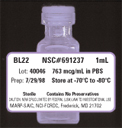DTP Branches and Offices
Success Story

In early trials, 11 of 13 patients with hairy cell leukemia had complete remissions after receiving BL22. Courtesy of NCI.
CD22-directed immunotoxins
“We expected that some patients would respond to the treatment, but we didn't imagine in our wildest dreams that almost all of the patients would go into complete remission. Half of the patients went into complete remission after a single cycle of treatment, and that was exciting to see.”4
Dr. Ira Pastan's intramural NCI laboratory has "used genetic engineering to modify a powerful bacterial toxin, Pseudomonas exotoxin A (PE), so that instead of killing normal cells it selectively kills cancer cells. PE is a three-domain protein composed of 613 amino acids derived from Pseudomonas exotoxin."1, 2 Anticancer agents are produced by deleting its binding domain and replacing it with the Fv fragment of an antibody or with a growth factor that binds to cancer cells. These agents are termed 'recombinant toxins.'3
1996
Many B-cell malignancies, including B-cell chronic lymphocytic leukemia (B-CLL), Burkitt's lymphoma, and hairy cell leukemia, express CD22 antigen on the tumor cell surface. This antigen is also expressed in normal B cells but not in B-cell precursors or stem cells. BL22 immunotoxin (NSC 691237), which directs the PE38 toxin to the CD22 receptor on lymphocytes, became a candidate for clinical development in September 1996.
Efficacy studies demonstrated complete remissions in approximately 80% of mice treated with the 200 microgram per kilogram dose; complete remissions were observed in 100% of the animals treated at higher doses.
The BDP was able to develop a complete, simple, and scalable clinical manufacturing process for immunotoxin production. A novel hydrophobic chromatography method was incorporated into the process to clearly separate the product, which elutes in a separate peak from the impurities. The new protocol almost tripled the yield of the final product and lowered the cost of production. This novel purification method has also been applied to other similar antibody-conjugated toxins, facilitating the manufacture of immunotoxin anticancer drugs in large scale.
1999
Clinical trials of BL22 began in 1999. The results were dramatic. Complete responses were observed for 11 out of 12 patients with drug-resistant hairy cell leukemia, a 92% response rate. The drug has progressed to phase II clinical trials at NCI, involving patients with hairy cell leukemia.
1 Kreitman RJ, Margulies I, Stetler-Stevenson M, Wang QC, FitzGerald DJ, Pastan I. Cytotoxic activity of disulfide-stabilized recombinant immunotoxin RFB4(dsFv)-PE38 (BL22) toward fresh malignant cells from patients with B-cell leukemias. Clin Cancer Res 2000;6:1476–1487.
2 Kreitman RJ, Pastan I. Immunobiological treatments of hairy-cell leukemia. Best Pract Res Clin Haematol 2003;16:117–133.
3 From Dr. Pastan's home page.
4 National Institutes of Health. Scientists report complete remissions in early leukemia trial.
Links:





